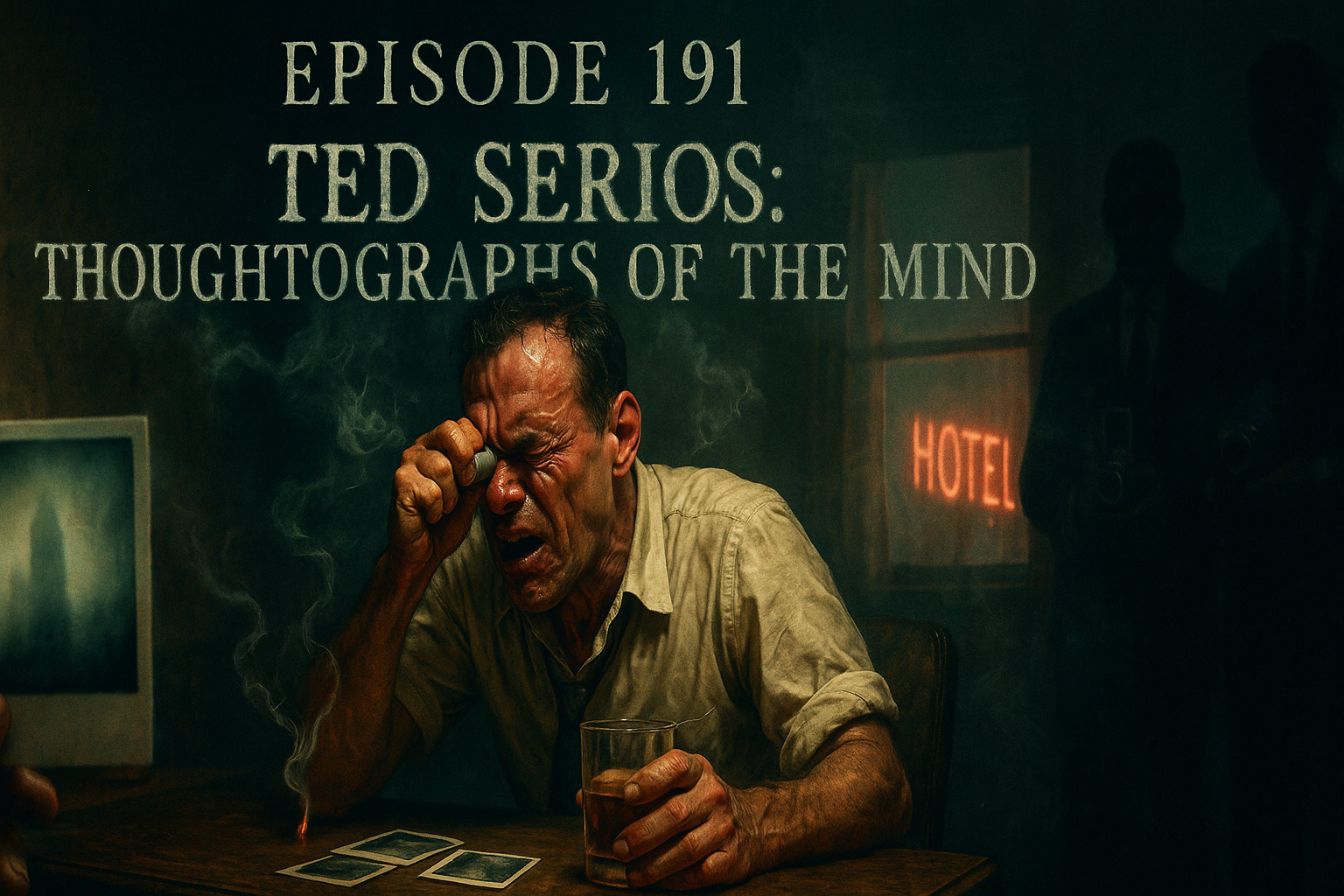Blog Post: Exploring Ted Serios and the Mystery of Thoughtography

✍️ Author: Juniper Ravenwood
The Enigma of Ted Serios
In episode 191 🎙️ of The Shadow Frequency, we plunged into the shadowy world 🌑 of Ted Serios, a Chicago bellhop 🛎️ whose alleged ability to project mental images 🧠📸 onto Polaroid film—known as thoughtography—captivated and confounded researchers in the 1960s.
Picture this: a smoke-filled hotel room 🚬🏨, a man trembling in a trance 😵, his face contorted as he clutches a small tube to his forehead, shouting “Now!” as a Polaroid camera 📷 flashes—capturing something impossible: a building he’s never seen 🏢, a barn from decades past 🌾, or an aircraft hangar from another country ✈️.
This is the unsettling legacy of Ted Serios… and it’s a story that still sends shivers down my spine 🥶.
A Bellhop’s Strange Gift
Ted Serios wasn’t your typical paranormal figure 👤. Born in 1918 📅, he was a rough-around-the-edges Chicagoan 🌆 with a penchant for whiskey 🥃 and a history of minor run-ins with the law 🚔.
By the early 1960s, while working as a bellhop at the Conrad Hilton Hotel 🏨, he stumbled into something extraordinary 🌌 during hypnosis sessions 🌀 with a coworker. Ted claimed he could project images from his mind onto photographic film, a process he called thoughtography 📸.
Unlike psychic mediums or clairvoyants 🔮, Ted’s method was raw and chaotic ⚡—think less serene meditation 🧘 and more frenzied ritual 🔥. He’d grip his “gizmo” (a small tube, often just a rolled-up piece of paper) 📜, press it to his head, and enter a trance-like state 😵, shouting and trembling until the Polaroid developed eerie images 👻.
The Polaroids That Defied Reality
The images Ted produced were what made this case so gripping 👁️.
📷 One session, overseen by Denver psychiatrist Dr. Jule Eisenbud 🧪, produced a thoughtograph of a Royal Canadian Mounted Police hangar 🍁—down to exact details—even though Ted had never visited Canada.
🏚️ Another showed Eisenbud’s barn, but not as it stood in the 1960s; it appeared decades earlier, without modern additions, as if time itself had been peeled back.
These weren’t crisp photographs 📸❌ but ghostly, smudged impressions 🌫️—like memories pulled from a fog. Eisenbud ran hundreds of experiments (1964–1966), sometimes under tight controls 🔒, yet the images kept coming. Today, many are archived at the University of Maryland 📚.
A Glimpse into the Unknown?
What makes Ted’s story so chilling 🥶 is the question of how.
Was he tapping into a collective unconscious 🌍🧠, pulling fragments of time and place from a cosmic archive 📜✨? Were his thoughtographs glimpses of a hidden frequency 📡 where thoughts shape reality?
His process felt cinematic 🎬 and horrific 👁️—bloodshot eyes 👀, trembling hands 🤲, collapsing in exhaustion 💀—as if he had wrestled with something beyond himself.
The Skeptic’s Shadow
Of course, skeptics 🧐 had their say.
📸 In 1967, photographers Charlie Reynolds and David Eisendrath claimed they caught Ted slipping a transparency into his gizmo, suggesting sleight-of-hand 🎩.
🪞 Later, James Randi reproduced similar effects, branding Ted a conman.
Yet… many images came under conditions where trickery seemed impossible 🕵️.
Why This Case Haunts Us
As the producer of The Shadow Frequency 🎧, I’m drawn to stories like Ted’s because they force us to question reality 🌀.
Whether you see him as a psychic pioneer 🚀 or a clever trickster 🎭, his thoughtographs dare us to wonder: Could our minds hold power strong enough to etch onto reality itself?
Next time you’re alone in the dark 🌒, maybe think twice before picking up a Polaroid camera 📷… you never know what might develop 👻.
Join the Conversation
💌 What do you think about Ted Serios and his thoughtographs?
Share your thoughts at shadowpodcast@protonmail.com or connect with us on socials:
🌐 shadowfrequencypodcast.com
📘 Facebook: Shadow Frequency Podcast
▶️ YouTube: @shadowfrequencypodcast
🎵 TikTok: shadowfrequencypodcast
Thanks for tuning in to episode 191 🙏, and we’ll see you in the shadows 🌑🕯️.
Signed,
Juniper Ravenwood 🦉























